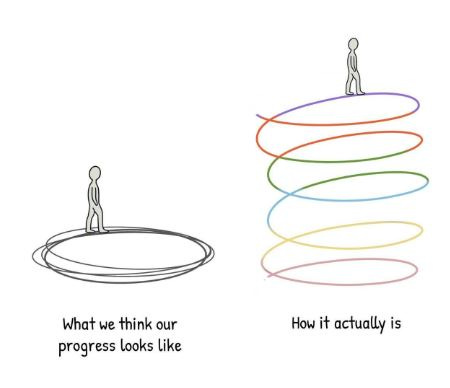When Projects Turn Red: Navigating the Wave When It Hits
Project management styles evolution
Welcome to the Agile Admiral weekly newsletter. Your Essential Resource for Project Management Excellence.
Each week, I tackle reader questions about PMP preparation, how to implement PMP into real-life projects, and a Senior Project Manager career.
For more: Project vs. Change Management | The Chaos Coordinator | The Project Habit You’re Probably Skipping | Power of Lessons Learned | Macro vs Micro Goals for PMs | PM without authority is just a punching bag with a calendar |
What's Inside This Edition:
The shift from Command-and-Control
When Projects Turn Red: Navigating the Wave When It Hits
Shift the perspective
“We are not going in circles, we are going upwards. The path is a spiral; we have already climbed many steps.”
Source: Sahil Bloom newsletter, including image from Maunika studios
The shift from Command-and-Control
For decades, we told PMs:
📌 “Stick to the plan.”
📌 “Follow the process.”
📌 “Hit the deadline.”
We trained robots. Not leaders.
But here’s the truth: I teach every PM I coach:
✅ You’re not a task tracker.
✅ You’re not a meeting scheduler.
✅ You’re a project manager
Today’s most effective PMs don’t just manage scope, they manage humans in chaos. Let’s look at the shift:
🛠 1950s: Obey the plan
📄 1960s: Follow the process
📈 1980s: Hit the KPIs
⚡ 2000s: Deliver value (Agile!)
🧠 2010s: Adapt and include
🤖 2025: Lead with empathy + AI
We’ve gone from control freaks to change facilitators and some people still haven’t caught up.
💬 If you still think project management is about Gantt charts and checklists…You’ve already lost your team.
🧠 The future?
PMs who coach, care, and co-create with tools AND empathy.
What do you think? Are we managing projects or managing people?
When Projects Turn Red: Navigating the Wave When It Hits
There are some things in life you can count on - tides, taxes and for project managers... that moment when a project veers off course and sails straight into the RED.
The Inevitable Storm
As project managers, we plan meticulously. We create roadmaps, identify risks and establish contingencies. Yet no matter how thorough our preparation, that dreaded RAG status report with the glaring red indicator eventually finds its way to our project dashboard. It's not a question of if, but when.
What separates seasoned project managers from the rest isn't avoiding these moments; it’s how they respond when the wave hits.
When Red Was Almost Inevitable
Before diving into recovery tactics, we must acknowledge an uncomfortable truth: sometimes a project was destined to turn red from its inception. Unrealistic initial timelines, the optimism bias where we underestimate complexity [a previous article "The Calibrated Project Manager - Adjusting for Planning Bias" explores this concept in more detail.]… or insufficient discovery building on assumptions rather than facts...
Remember: "Assumptions are the death of plans!" ☠
Resource misalignment and competing priorities compound the problem when teams are stretched across too many initiatives without clear organisational focus.
Recognising these conditions doesn't absolve us of responsibility - but it does change how we approach recovery. Sometimes reaching green requires not just execution excellence but fundamental renegotiation of the project's scope and parameters.
Navigating the Unknown Unknowns
When projects hit red status, it's valuable to distinguish between different types of challenges: Known Knowns (risks we identified and planned for), Known Unknowns (uncertainties we were aware of but couldn't fully quantify) and Unknown Unknowns - the truly unforeseen events that blindside even the most diligent teams.
The most comprehensive risk management addresses the first two categories, but it's often the third - those unknown unknowns, that send projects spiralling into the red with little warning. This is why proactive and regular risk management is vital, especially in large complex multi-dependency programmes. Through the fog of unknown unknowns, you might just be able to identify a dangerous rock looming and take just enough of a pivot to minimise damage to the vessel and crew.
Building Resilience Against the Unforeseen
Proactive project managers don't just plan for identified risks; they build adaptive capacity. This means creating buffer allocation beyond identified risks, designing modular project structures that can be reconfigured when surprises emerge and establishing rapid response protocols.
Remember the old saying: "under promise and over deliver". Too many reverse this, leading to regular 'Return to Green' phases and replans. The most successful project managers shift from "preventing all surprises" to "building resilience for inevitable surprises.”
The reality is the project still takes the time it takes, but managing expectations well builds confidence and trust with your sponsor (and opens the door for you to lead even larger projects in the future)!
The Art of Recovery
When projects go red, the inner dialogue is often harsh: Why did I miss this? What signals did I ignore? How could I have prevented this? These reflections are natural, but in the moment of crisis, they must be temporarily shelved. There will be time for lessons learnt, but first, there's a ship to turn.
Rally your alliances and call on the relationships you've been nurturing (when the waters were calm); your relationship capital matters most in these moments. Establish incremental goals that create visible wins to rebuild confidence, and maintain transparent communication because stakeholders can accept setbacks but rarely forgive being kept in the dark.
The journey requires decisive prioritisation, distinguishing between what must be done now and what can wait. Sometimes, success means fixing the underlying problem. Other times, it means reframing what success looks like. Document everything… your recovery process will become valuable organisational knowledge (and maybe useful lessons learned referenced by future initiatives).
Most importantly, remain visibly engaged and calmly determined. Your team will take their cues from your response.
Beyond Technical Fixes
"Return to Green" isn't just a status update; it’s a multi-dimensional effort of trust-building, problem-solving and resilience. The journey requires supporting your team through the challenges without burning them out, and sometimes resetting timelines or deliverables is the most honest path forward.
Either way, it takes more than process… it takes presence.
After the Storm
Once the immediate crisis passes, the real growth begins. Create space for honest reflection: What early warning signs did we miss? Which processes failed? How effective was our response? Were we set up to succeed from the start?
These conversations should focus on improvement, not blame. The goal isn't perfect projects; they don't exist, but building an organisation and a Crew that can respond to challenges with increasing skill and confidence.
You Were Built for These Waters
The red status is inevitable. Your response to it is not. By combining analytical problem-solving with emotional intelligence, contextual awareness and genuine leadership, you can turn these challenging moments into opportunities for growth… both for yourself, your Crew and your organisation.
The sea may be rough, but you were built for these waters. Now, captain, it's time to turn the ship! 🏴☠
Thank you for reading. Appreciate you!
Did you know that most PMs spend 4-6 months preparing for PMP?
PMP prep is not a weight-loss program. Here are my solutions for you, if you committed to study only 8 weeks:
👉🏼Do it together - join the PMP Operation System
https://gaborstramb.com/
👉🏼Do it 1-on-1 - join 8-week coaching program







A lot of evolutionary work is about to come . Just waiting for the exciting times by being ready and prepared! Thanks for the insights!! @Gabor